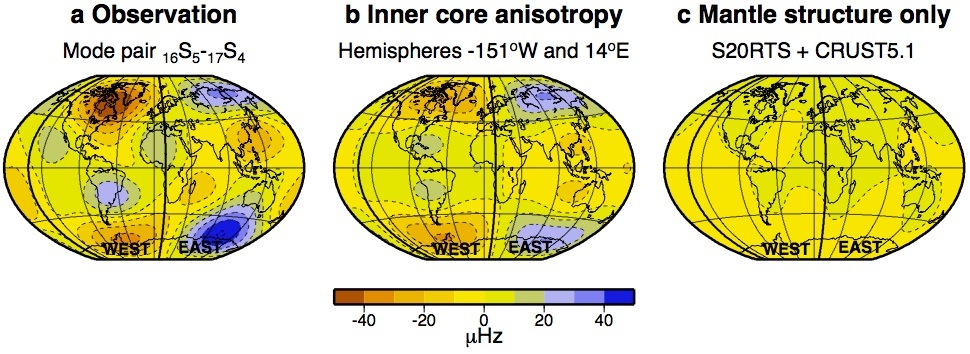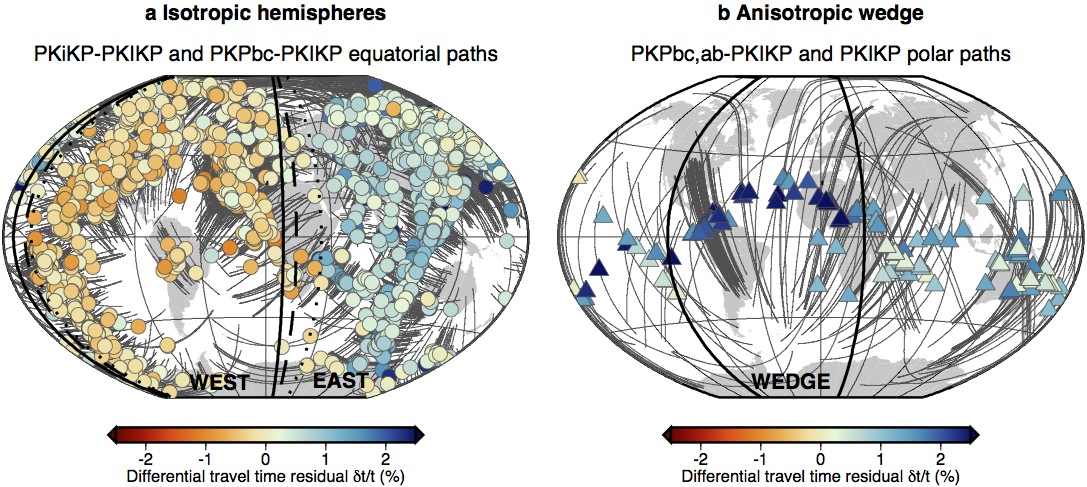Inner Core
The core, comprising the innermost parts of the Earth, is one of the most dynamic regions of our planet. The inner core is solid, surrounded by an outer core of a liquid iron alloy. Inner core solidification combined with motions in the fluid outer core drive the geodynamo which generates the Earth’s magnetic field. Solidification of the inner core also supplies some of the heat which drives mantle convection and subsequently plate tectonics at the surface of the Earth. The thermal and compositional structure of the inner core is thus key to understanding the inner workings of our planet.
Previous seismic studies (including our own) using compressional body waves had suggested the existence of hemispherical variation in the anisotropic structure of the inner core, but were poorly constrained because of limited earthquake and receiver distribution and the use of approximate ray theory. Lack of theory and observational limitations, had prevented these structures from being seen using whole Earth oscillations which are studied using exact techniques. We developed novel normal mode cross-coupling techniques, to model complex elastic and anelastic inner core anisotropy. We also made a new data set of normal mode splitting function observations. Combining our new methodologies and body wave and normal mode data sets we made a comprehensive model of the Earth’s inner core.
Our normal mode observations of inner core anisotropy show a rich pattern of regional variation in addition to a simple eastern versus western hemispherical division. The similarity of this pattern with the Earth’s magnetic field might suggests a freezing-in origin of crystal alignment during inner core solidification or texturing by Maxwell stress as origins of the anisotropy. Using body waves, we subsequently found that the hemispherical pattern at the top of the inner core is divided by sharp boundaries which are dipping eastwards as a function of depth, limiting inner core superrotation to much slower speeds than previously thought. This much slower rate is in excellent agreement with recent geodynamo simulations and reconciles two properties previously thought incompatible. We also observed attenuation anisotropy using normal modes, and found that it is most likely due to Zener relaxation, which requires the presence of light elements in the inner core. Our seismic observations are already being used as constraints by fluid dynamicists, mineral physicists and material scientists to find mechanisms to explain the existence of hemispheres and anisotropy in the inner core.
Our research on the core has been funded by a starting grant from the European Research Council from 2008 until 2014.
Reviews
- Deuss, A. (2014). Heterogeneity and anisotropy of the Earth’s inner core, Annual Review of Earth and Planetary Sciences 42, p.103-126
Key publications
- Mäkinen, A.M., Deuss, A. and S.A. Redfern (2014). Anisotropy of Earth’s inner core intrinsic attenuation from seismic normal mode models, Earth and Planetary Science Letters 404, p.354-364
- Lythgoe, K., Deuss ,A., Rudge, J. and J. Neufeld (2014). Earth’s inner core: innermost inner core or hemispherical variations?, Earth and Planetary Science Letters 385, p.181-189
- Waszek, L. and A. Deuss (2013). A low attenuation layer in Earth’s uppermost inner core, Geophysical Journal International 195 (3), p.2005-2015
- Mäkinen, A. and A. Deuss (2013). Normal mode splitting due to inner core attenuation anisotropy, Geophysical Journal International 195 (3), p.1786-1795
- Mäkinen, A. and A. Deuss (2013). Normal mode splitting function measurements of anelasticity and attenuation in the Earth’s inner core. Geophysical Journal International 194 (1), p.401-416
- Mäkinen, A., and A. Deuss (2011). Global seismic body-wave observations of temporal variations in the Earth’s inner core, and implications for its differential rotation, Geophysical Journal International 187 (1), p.355–370
- Waszek, L. and A. Deuss (2011). Distinct layering in the hemispherical seismic velocity structure of Earth’s upper inner core, Journal of Geophysical Research 116 (B12), doi:10.1029/2011JB008650
- Irving, J. C. E., and A. Deuss (2011). Stratified anisotropic structure at the top of Earth’s inner core: A normal mode study, Physics of the Earth and Planetary Interiors 186 (1-2), p.59-69
- Irving, J. C. E., and A. Deuss (2011). Hemispherical structure in inner core velocity anisotropy, Journal of Geophysical Research 116 (B04307), doi:10.1029/2010JB007942
- Waszek, L., Irving, J. C. E. and A. Deuss (2011). Reconciling the hemispherical structure of Earth’s inner core with its super-rotation, Nature Geoscience 4, p.264–267
- Deuss, A., Irving, J. C. E. and J. H. Woodhouse (2010). Regional variation of inner core anisotropy from seismic normal mode observations, Science 328 (5981), p.1018-1020
- Irving, J.C.E., Deuss, A., and J. H. Woodhouse (2009). Normal mode coupling due to hemispherical anisotropic structure in Earth’s inner core, Geophysical Journal International 178 (2), p.962-975
- Irving, J.C.E., Deuss, A., and Andrews, J. (2008). Wide-band coupling of Earth’s normal modes due to anisotropic inner core structure, Geophysical Journal International 174 (3), p.919-929
- Deuss, A. (2008). Normal mode constraints on shear and compressional wave velocity of the Earth’s inner core, Earth and Planetary Science Letters 268 (3-4), p.364-375
- Andrews, J., Deuss, A., and Woodhouse, J. H. (2006). Coupled normal-mode sensitivity to inner-core shear velocity and attenuation, Geophysical Journal International 167 (1), p.204-212
- Deuss, A., Woodhouse, J. H., Paulssen, H, and Trampert, J. (2000). The observation of inner core shear waves, Geophysical Journal International 142 (1), p.67-73

